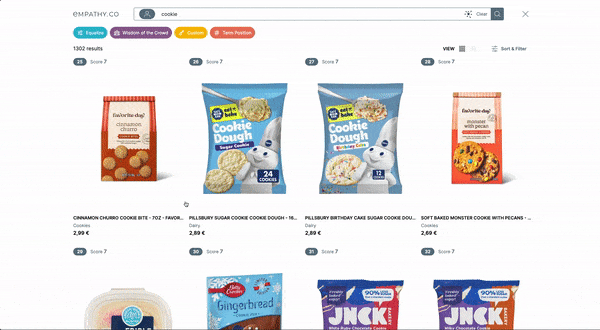This Valentine’s Day… did your search experience fill your customers with love?
This Valentine’s Day… did your search experience fill your customers with love?
Did you receive or find that special gift for that special someone this Valentine’s Day? Gifting days can often be a nightmare for people who are desperately looking for the right present. While there is a high purchase intent this is often accompanied by a bewilderment about what to buy that can lead to us desperately buying something even though we know it’s not quite right.
 We know from our data that many flower, chocolate or lingerie retailers will receive a large number of queries and visits the week before Valentine’s Day, when people are browsing with a high sense of
discovery
but when the
purchasing need
is not so urgent. However most of the actual purchases won’t take place until the day or two before the gifting day.
We know from our data that many flower, chocolate or lingerie retailers will receive a large number of queries and visits the week before Valentine’s Day, when people are browsing with a high sense of
discovery
but when the
purchasing need
is not so urgent. However most of the actual purchases won’t take place until the day or two before the gifting day.
This shopping behaviour is really apparent in Omnichannel brands where shoppers will often browse the online store ahead of time and then make the actual purchase in the physical shop.
The search and discovery phase usually takes place online some days before the special date when customers will look at the different product options and familiarise themselves with the catalogue. The final purchase will then most likely take place, whether offline or online, a few days after the search and discovery experience and usually close to the gifting date itself.
The following example shows data from an online lingerie brand over the last two weeks. We can see a large volume of queries the week before Valentine’s Day but the peak in add to carts is happening in the last couple of days before the 14
th
February.
 We also saw this pattern when looking at
Interflora’s search data
last year with the most popular time to buy flowers being 5pm on 13
th
February and midday on Valentine’s Day itself, suggesting a lot of last minute planning! However, the data also revealed that while the discovery period often starts much earlier the use of search also increases during this period as people are not just looking for something specific but are also hoping to be inspired.
We also saw this pattern when looking at
Interflora’s search data
last year with the most popular time to buy flowers being 5pm on 13
th
February and midday on Valentine’s Day itself, suggesting a lot of last minute planning! However, the data also revealed that while the discovery period often starts much earlier the use of search also increases during this period as people are not just looking for something specific but are also hoping to be inspired.
Independently of when or where the final transaction is performed, customers need to feel inspired and guided along the gift discovery phase with retailers offering good options and suggestions. This provides a great opportunity for brands to really connect with their customers demonstrating understanding and empathy. However, if they don’t get this right then users will not only be left feeling disappointed but may not come back, either to the online or offline store.
This is why it’s so important to tailor the shopping experience to the specific attributes and needs of shoppers on special dates like gifting days. Providing a wide selection of suggestions and ways to refine a query during the discovery phase is critical to engage with shoppers while also displaying the best options within the store’s catalogue.
It’s also really important to provide relevancy and user context, understanding who the shopper is buying for and their relationship with that person, their budget and so forth as well as making the shopping experience entertaining and joyful. After all, the gift is for someone else so the experience needs to fun and engaging or there is a risk that the buyer may lose interest.
There are lots of different tactics to improve the discovery experience, and below we’ve outlined a few key functionalities designed to help users find the right product, even when they don’t have a clear idea of what they’re looking for.
Profiling
Profiling can be done explicitly through the use of a quiz or multiple selection forms. Media outlets such as NYTimes, Medium and Pinterest frequently use interest tags for profiling their user’s interests. This can also be done in a way that’s entertaining and fun as per this example from Mulberry.
 Search technology can also be applied smartly in the user profiling phase to help with the selection process. The search box can be used as the driver for a structured selection of options or even as a gift finder.
Search technology can also be applied smartly in the user profiling phase to help with the selection process. The search box can be used as the driver for a structured selection of options or even as a gift finder.

Search Suggestions
Another important search component that makes the discovery experience fun and engaging is search suggestions and trends. “People who searched for this also searched for” or “Trending now” as well as “Picks for you.”
For this magic to happen a set of signals, such as queries, clicks, likes, purchases and so on must be collected, processed and computed first in order to deliver relevant predictions and suggestions to each single person.
It’s also key to understand and differentiate between the shopper’s own personal tastes and the gifting preferences, ensuring that the two profiles are kept distinct and that the gifting experience does not affect or influence the individual’s own future shopping results and experiences.

Recommendations
Search recommendations also work really well when users don’t have a very well-defined product idea and seek inspiration.
‘Related tags’
are automatically populated on the results page to act as refinement recommendations. Users then have the option to select any of these to narrow down the search.
 ‘
Next Queries
’ can be also be displayed when scrolling down the results grid to provide more options based on the searches by other users after the same initial query.
‘
Next Queries
’ can be also be displayed when scrolling down the results grid to provide more options based on the searches by other users after the same initial query.

Special dates, with such high purchase intent, offer a great sales opportunity to retailers but only if the discovery process is well thought out and delivered with gift suggestions that are relevant and tailored, in as human a way as possible.
On days like Valentine’s Day, brands have the opportunity to create exceptional, really tailored and engaging experiences. Through search data and a deeper knowledge and better understanding of customers, retailers can ensure consumers not only feel more connected to a brand that gets them and understands their needs but can offer more enjoyable, joyful and meaningful shopping experiences, turning even the least loyal, most skeptical consumers into brand devotees.
To learn more about creating tailored and targeted digital experiences on special dates download our Special Dates Guide .










